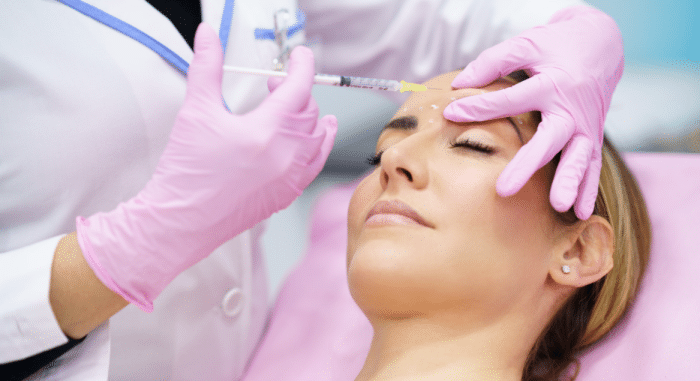
Safety Showdown: Botox vs. Profhilo – Which Treatment Comes out on Top?
David Fuller
Last Updated On: August 15, 2024
According to The International Society of Aesthetic Plastic Surgery, in 2020, around 21.1 million cosmetic procedures were performed on females, constituting most of the 24.5 million treatments worldwide. Notably, botulinum toxin (Botox) treatments have seen a 26.1% increase, maintaining their position as the most common non-surgical procedure globally. This highlights a growing trend towards minimally invasive treatments.
Botox, known for its wrinkle-smoothing capabilities, contrasts with Profhilo, which enhances skin hydration and elasticity. The decision between these treatments hinges on various factors, including desired outcomes, tolerance for downtime, and long-term effects.
This article will explore the safety, effectiveness, and consumer preferences surrounding Botox and Profhilo, two of the most discussed non-surgical treatments.
Key Takeaways
- Botox and Profhilo cater to different aesthetic needs: Botox smooths wrinkles by temporarily paralyzing muscles, while Profhilo enhances skin hydration and elasticity without affecting muscle activity.
- Both treatments are popular, with Botox leading in reducing dynamic wrinkles and Profhilo preferred for improving skin quality.
- Safety profiles of both treatments are generally favorable, with common side effects being mild and related to injection sites. Botox has a long-standing record of safety and efficacy. Profhilo, although newer, shows promise with minimal risk of adverse reactions.
- Patient satisfaction tends to be high for both, with their preferences depending on specific aesthetic goals—Botox for muscle-related concerns and Profhilo for skin hydration and firmness.
- Professional advice is crucial in choosing between them, with some individuals potentially benefiting from a combination of treatments to achieve desired results.
Understanding Botox

What is Botox?
Botox, scientifically known as Botulinum toxin, is a highly potent neurotoxic protein produced by the bacterium Clostridium botulinum and related species. It functions by inhibiting the release of the neurotransmitter acetylcholine from axon endings at the neuromuscular junction, which results in flaccid paralysis.
Although it is recognized for causing the disease botulism in large amounts, in controlled, small doses, it is used for both medical and cosmetic purposes. This substance can block nerve activity in the muscles, temporarily reducing muscle activity.
Common Uses and Application Areas
Botox, also recognized as a potent wrinkle remover, is extensively used for various applications, including the temporary improvement of facial wrinkles, such as glabellar lines (frown lines between the eyebrows), crow’s feet (lines around the eye), and forehead lines. Beyond its cosmetic applications as a wrinkle remover, Botox serves several medical purposes.
It treats conditions involving overactive muscle movements, like cerebral palsy, post-stroke spasticity, head and neck spasms, eyelids, limbs, jaw, and vocal cords. Additionally, it is used for managing conditions such as cervical dystonia (a neurological disorder causing severe neck and shoulder muscle contractions), blepharospasm (uncontrollable blinking), strabismus (misaligned eyes), chronic migraine, and overactive bladder.
Safety Profile and Potential Side Effects
While Botox injections are generally considered safe for both cosmetic and therapeutic uses when administered by a qualified healthcare professional, they can have side effects. The most common side effects are pain, swelling, or bruising at the injection site. Other possible side effects include flu-like symptoms, headache, and upset stomach. Injections in the face may cause temporary drooping eyelids.
Exploring Profhilo
What is Profhilo?
Profhilo is a relatively new treatment in aesthetic medicine designed to improve skin tone, texture, hydration, and overall radiance. Unlike Botox, Profhilo does not work by affecting muscle activity but instead focuses on treating the skin directly. Profhilo is injected into the skin as a powerful hydrator, stimulating collagen and elastin production and improving skin quality.
Key Benefits and Treatment Areas
The key benefits of Profhilo include improved skin hydration, firmness, elasticity, and an overall rejuvenated appearance. It is particularly effective for treating signs of aging in the skin, such as fine lines and wrinkles, without altering facial expressions or muscle activity. Profhilo can be used on the face, neck, décolletage, hands, and other areas that may benefit from increased skin firmness and hydration.
Safety Considerations and Side Effects
Profhilo is considered a safe treatment with minimal side effects owing to its hyaluronic acid composition, a substance naturally present in the body. Common side effects are mild and may include redness, swelling, and bruising at the injection sites, which typically resolve within a few days post-treatment. Given its relatively recent introduction to the market, long-term safety data is still being gathered.
Mechanism of Action

How Botox Works
Botox blocks nerve signals responsible for muscle contraction and temporarily relaxes the injected muscles. This process reduces the appearance of wrinkles and can last about 3-6 months. Botox’s effect comes from its ability to prevent the release of the neurotransmitter acetylcholine at the neuromuscular junction, which is essential for muscle contraction.
How Profhilo Functions
Unlike Botox, Profhilo doesn’t work by affecting muscle contraction. Instead, it is based on hyaluronic acid, which hydrates the skin from within and stimulates collagen and elastin production. This leads to improved skin quality and texture. Profhilo is often described as an “injectable moisturizer” because it enhances the skin’s natural hydration and firmness by stimulating the body’s biological processes.
Comparative Analysis of Their Actions
The primary difference between Botox and Profhilo lies in their mechanisms of action. Botox temporarily paralyzes muscles to reduce the appearance of wrinkles. At the same time, Profhilo improves skin texture and elasticity through hydration and collagen stimulation. Botox addresses cosmetic concerns like wrinkles and fine lines by acting on the muscles.
Safety and Efficacy
Clinical Studies on Botox Safety
Botox has been extensively studied and approved for cosmetic and therapeutic use. Its safety profile is well-established, with common side effects including bruising, edema, or pain at the injection site.
More severe complications are rare and usually associated with the injection technique or the patient’s underlying conditions. Botox’s contraindications include neuromuscular disorders, allergies to its components, pregnancy, and breastfeeding, among others.
Research Findings on Profhilo’s Safety
Profhilo is relatively new compared to Botox but has been approved based on its safety and efficacy. It is generally well-tolerated, with minimal risk of allergic reaction. The treatment’s side effects are similar to those of other injectables, such as temporary swelling or bruising at the injection sites.
Efficacy Comparison
Both treatments are effective in their respective areas; Botox is most effective for reducing the appearance of dynamic wrinkles caused by muscle movements. Profhilo is beneficial for improving skin hydration, texture, and firmness. While Botox offers a more targeted approach for wrinkles and fine lines, Profhilo enhances skin quality.
Side Effects and Complications
Botox: Risks and Recovery
Botox is generally safe and minimally invasive, with a quick recovery allowing for a return to daily activities almost immediately. Common side effects include mild pain or swelling at the injection site, flu-like symptoms, and occasionally temporary eyelid drooping, typically resolving within days. Rarely, severe reactions like vision issues or difficulty swallowing may occur, necessitating medical advice.
The full effects are visible within 10 to 14 days, with follow-up treatments every 3 to 4 months recommended to maintain results. Initial post-injection recommendations include avoiding strenuous activities and keeping the area elevated to minimize swelling.
Profhilo: Risks and Recovery
Information specific to Profhilo’s side effects and recovery process was covered differently. However, as with many injectable treatments, typical side effects likely include mild swelling, redness, and bruising at the injection sites, which typically subside within a few days.
Since the substance’s composition is primarily hyaluronic acid, naturally present in the body, the risk of severe side effects is relatively low, and recovery is usually quick.
Patient Satisfaction and Preferences
Botox Patient Reviews
Patient satisfaction with Botox tends to be high, particularly because of its effectiveness in reducing the appearance of wrinkles and treating various medical conditions. The quick recovery time and minimal discomfort during and after the procedure increase popularity among patients seeking cosmetic and therapeutic benefits.
Profhilo Patient Feedback
While specific patient feedback on Profhilo was not detailed in the sourced information, it is generally well-received for its skin hydrating and bio-remodeling capabilities. Its ability to improve skin texture, elasticity, and overall appearance without affecting muscle movement makes it a favored choice for individuals looking for non-invasive skin rejuvenation solutions.
Professional Recommendations
When to Choose Botox
Botox is a versatile treatment for smoothing out dynamic wrinkles caused by repetitive facial expressions like frowning, smiling, or squinting. These include forehead lines, crow’s feet around the eyes, and glabellar lines between the eyebrows.
It’s also effective in treating medical conditions such as hyperhidrosis (excessive sweating), chronic migraines, and overactive bladder by blocking the release of acetylcholine.
When to Choose Profhilo
While specific guidelines for choosing Profhilo over other treatments weren’t directly covered, Profhilo is more suitable for individuals looking to enhance skin quality, hydration, and elasticity without needing muscle relaxation.
Profhilo, based on hyaluronic acid, works by improving skin texture and firmness, making it an excellent option for those seeking a more youthful, radiant appearance without targeting muscle activity.
Conclusion
The choice between Botox and Profhilo depends on individual aesthetic goals. Botox is the go-to for targeting dynamic wrinkles through muscle paralysis, and Profhilo is preferred for enhancing skin hydration and elasticity. Both treatments boast high safety profiles and patient satisfaction rates, emphasizing the importance of professional consultation to tailor treatment to individual needs.
As the aesthetic industry evolves, Botox and Profhilo remain integral, addressing different aspects of facial rejuvenation and skin health.
FAQs
- Is Botox safer than Profhilo?
Botox and Profhilo are considered safe for cosmetic use; however, the safety of each treatment depends on individual skin conditions and overall health. It’s essential to consult with a healthcare professional to determine the most suitable option based on your specific needs.
- Can I see results faster with Botox or Profhilo?
Results from Botox injections are typically noticeable faster when compared to Profhilo, with initial improvements often visible within a few days to two weeks after treatment.
- Do both treatments hurt?
Both treatments may involve a slight pinch or discomfort during injection, but the sensation is generally brief and manageable. Some clinics apply topical anesthetics to minimize discomfort.
- How long do the effects of Botox and Profhilo last?
Botox’s effects usually last between 3 and 4 months, whereas Profhilo treatments can provide improvements for up to 6 months, depending on individual factors such as skin type and the area treated.
- Which treatment is better for younger-looking skin?
Profhilo is renowned for its hydrating and skin-firming properties, making it an excellent choice for achieving a youthful, rejuvenated appearance. It enhances skin texture and tone by stimulating collagen and elastin production.
- Botox what age to start considering treatments?
The ideal age to begin Botox treatments varies for each individual and depends on factors such as skin condition and personal preference. While there’s no specific age requirement, some people start considering Botox in their late twenties to early thirties as a preventative measure against fine lines and wrinkles. Consulting with a qualified healthcare provider can help determine the best time to start Botox based on your unique circumstances and aesthetic goals.
References
Zanchi, M., Favero, G., Bizzego, A., Sbarbati, A., & Alaibac, M. (2021). Botulinum Toxin Type-A for the Treatment of Hyperhidrosis: A Review. International Journal of Molecular Sciences, 22(4), 1927. https://doi.org/10.3390/ijms22041927
Elle UK. (n.d.). Profhilo: The ‘Injectable Skincare’ Treatment That Promises To Give You Plump, Glowing Skin. Retrieved from https://www.elle.com/uk/beauty/skin/a39596754/profhilo/
American Academy of Ophthalmology. (2021, March 4). How Does Botulinum Toxin (Botox) Work? Retrieved from https://www.aao.org/eye-health/treatments/how-does-botulinum-toxin-botox-work
International Society of Aesthetic Plastic Surgery. (2022). ISAPS Global Survey 2022 Full Report and Press Releases. Retrieved from https://www.isaps.org/discover/about-isaps/global-statistics/reports-and-press-releases/global-survey-2022-full-report-and-press-releases/
Products
Cart
Log In
Newsletter
Subscribe for exclusive offers and updates on new arrivals
Share feedback at:
Working Hours
MON - SUN 9AM to 6PM EST
The Most Popular Brands
Med Supply Solutions
Support
Secure checkout is guaranteed with full adherence to PCI DSS payment standards.
Products listed here are guaranteed authentic and manufacturer-sourced.
Pay easily with trusted providers


Copyright 2025. Med Supply Solutions